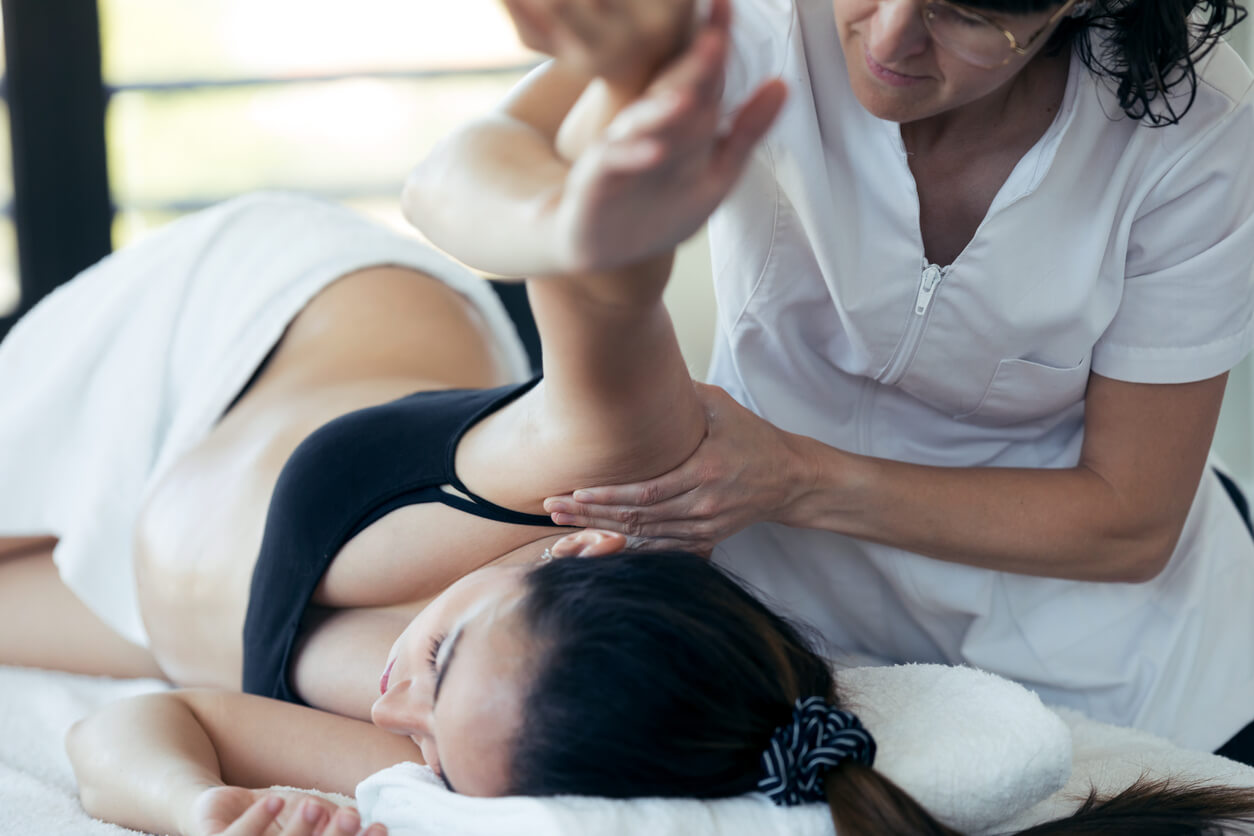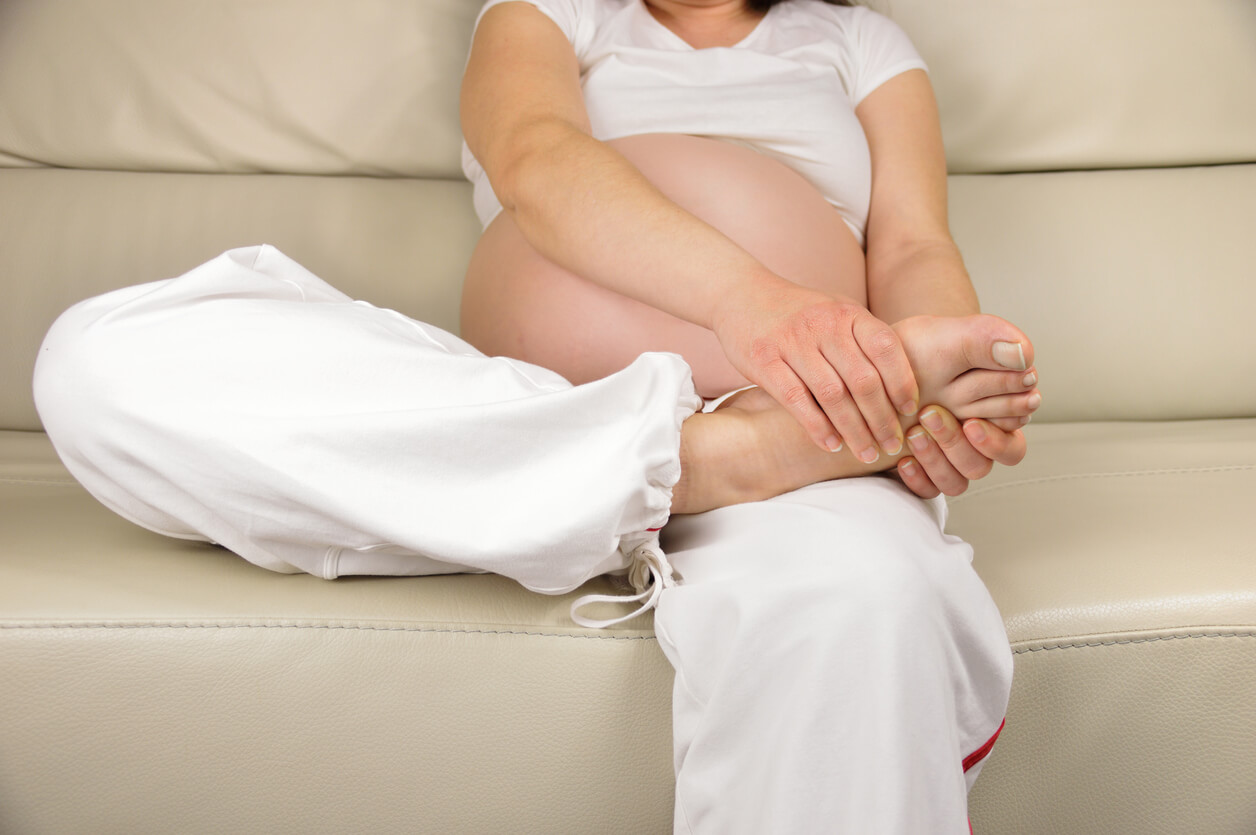Massage During Pregnancy: Everything You Need to Know


Written and verified by the physiotherapist Maria Elisa Lisotti Luppi
Massage during pregnancy is no longer a simple caress, but a great element of relief in a physiological process as complex as pregnancy. The growth of the baby inside the mother’s belly requires several changes in her anatomy, among them, abdominal distension, which produces greater tension in the muscles of the lower back.
The mother’s body weight increases, which changes the way she moves. Blood and lymphatic circulation are also affected. Added to this are the emotional changes, which in some cases are accompanied by moments of anxiety. As pregnancy progresses, sleep is altered due to hormonal changes and the baby’s growth.
Massages are manual maneuvers that are used instinctively, with different objectives. During pregnancy, they’re performed to reduce postural discomfort, improve circulation, and promote rest. It’s a good idea to start applying them from the second trimester of pregnancy. We’ll tell you everything you need to know to perform them.
What’s needed to perform massages during pregnancy?
First of all, you have to prepare everything before starting. You should prepare the space where the mother will be located and use cushions, chairs, or benches to adapt the posture according to her comfort.

Then, choose the gliding medium to be used; essential oils or specific creams for massages are good options. Always check the ingredients and make sure they don’t contain any drugs. You can add elements such as massage rollers, spheres, or balls, which are very useful for self-massage or to alternate with manual massage when it’s done by another person.
How to perform massage during pregnancy?
There are several massage techniques that are selected according to the desired objective. In the case of massage during pregnancy, priority is given to techniques that provide greater relaxation. The pressures should be gentle, according to the woman’s tolerance, with slow movements, and never on the most protruding parts of the bones. Among the most well-known techniques are the following:
- Rubbing: This is a very superficial and gentle contact; it’s applied with the fingertips. Just touching the skin, the fingers slide with long strokes across the area of the body that’s being worked. It’s a good option to start stimulating circulation.
- Kneading: It’s practiced with the entire palm of the hand in contact with the muscular area to be treated. The thumbs and index fingers are joined together, forming a rhombus. The surface delimited between the fingers is the one to be gently kneaded, moving alternately one and the other hand, without losing contact between the fingers and, at the same time, with the woman’s skin.
Self-massage
It’s a good alternative when you don’t have another person at the time that you need a massage. Except for the back, the rest of the body is within reach of the pregnant woman’s hands. Facial massages are easy to apply, as well as body massages, which can be included in the mother’s daily body care routines, for example, after showering, when applying lotion.
- Facial massages: Rub hands together to increase the temperature of the cream or oil. Cover the face with both hands and start by sliding from the center outwards. Then, with the fingertips, massage in circles the forehead, chin, cheekbones, and behind the ears.
- Body massages: Likewise, rub your hands together before starting. Then, gently knead the feet and then the legs as far as the size of the belly allows. From the seventh month onward, the most accessible areas will be the thighs, arms, and shoulders.
The duration of the massage session, whether applied by another person or self-massage, will depend on the tolerance and preference of each woman. Always considering some care and precautions regarding the postures chosen for the mother. Priority should be given to lying on the side, if possible, on the left side. Regarding the frequency, if the woman wishes, it’s possible to use them daily.
Depending on the stage of pregnancy that the woman is going through, the massages will focus on different areas. In the first trimester, they should only be applied to the neck and base of the skull. During the second trimester, discomfort in the mid-lower back is added. Toward the end of pregnancy, in the third trimester, the lower back, lumbar, sacrum, and buttocks comprise the areas of greatest discomfort.

The benefits of massage during pregnancy
There are several physical and emotional effects that massage during pregnancy provides. It provides immediate benefits in multiple systems of the mother-to-be’s body. Among them are the following:
- Improves blood and lymphatic circulation, which is affected by the compression caused by the growing baby
- Relaxes the woman’s tired muscles, which are strained by the weight of the abdomen
- Provides a feeling of general well-being, which promotes rest and improves sleep
- Reduces the sensations of pain in different regions of the body, typical of pregnancy
- Favors the release of endorphins, improving the mother’s mood
The treating physician should inform the mother-to-be if, for any specific health reason, massages are contraindicated during pregnancy. They can be applied to all women who have a healthy pregnancy, without complications, and can also be incorporated into the daily routine at any time of the day.
Massage during pregnancy is no longer a simple caress, but a great element of relief in a physiological process as complex as pregnancy. The growth of the baby inside the mother’s belly requires several changes in her anatomy, among them, abdominal distension, which produces greater tension in the muscles of the lower back.
The mother’s body weight increases, which changes the way she moves. Blood and lymphatic circulation are also affected. Added to this are the emotional changes, which in some cases are accompanied by moments of anxiety. As pregnancy progresses, sleep is altered due to hormonal changes and the baby’s growth.
Massages are manual maneuvers that are used instinctively, with different objectives. During pregnancy, they’re performed to reduce postural discomfort, improve circulation, and promote rest. It’s a good idea to start applying them from the second trimester of pregnancy. We’ll tell you everything you need to know to perform them.
What’s needed to perform massages during pregnancy?
First of all, you have to prepare everything before starting. You should prepare the space where the mother will be located and use cushions, chairs, or benches to adapt the posture according to her comfort.

Then, choose the gliding medium to be used; essential oils or specific creams for massages are good options. Always check the ingredients and make sure they don’t contain any drugs. You can add elements such as massage rollers, spheres, or balls, which are very useful for self-massage or to alternate with manual massage when it’s done by another person.
How to perform massage during pregnancy?
There are several massage techniques that are selected according to the desired objective. In the case of massage during pregnancy, priority is given to techniques that provide greater relaxation. The pressures should be gentle, according to the woman’s tolerance, with slow movements, and never on the most protruding parts of the bones. Among the most well-known techniques are the following:
- Rubbing: This is a very superficial and gentle contact; it’s applied with the fingertips. Just touching the skin, the fingers slide with long strokes across the area of the body that’s being worked. It’s a good option to start stimulating circulation.
- Kneading: It’s practiced with the entire palm of the hand in contact with the muscular area to be treated. The thumbs and index fingers are joined together, forming a rhombus. The surface delimited between the fingers is the one to be gently kneaded, moving alternately one and the other hand, without losing contact between the fingers and, at the same time, with the woman’s skin.
Self-massage
It’s a good alternative when you don’t have another person at the time that you need a massage. Except for the back, the rest of the body is within reach of the pregnant woman’s hands. Facial massages are easy to apply, as well as body massages, which can be included in the mother’s daily body care routines, for example, after showering, when applying lotion.
- Facial massages: Rub hands together to increase the temperature of the cream or oil. Cover the face with both hands and start by sliding from the center outwards. Then, with the fingertips, massage in circles the forehead, chin, cheekbones, and behind the ears.
- Body massages: Likewise, rub your hands together before starting. Then, gently knead the feet and then the legs as far as the size of the belly allows. From the seventh month onward, the most accessible areas will be the thighs, arms, and shoulders.
The duration of the massage session, whether applied by another person or self-massage, will depend on the tolerance and preference of each woman. Always considering some care and precautions regarding the postures chosen for the mother. Priority should be given to lying on the side, if possible, on the left side. Regarding the frequency, if the woman wishes, it’s possible to use them daily.
Depending on the stage of pregnancy that the woman is going through, the massages will focus on different areas. In the first trimester, they should only be applied to the neck and base of the skull. During the second trimester, discomfort in the mid-lower back is added. Toward the end of pregnancy, in the third trimester, the lower back, lumbar, sacrum, and buttocks comprise the areas of greatest discomfort.

The benefits of massage during pregnancy
There are several physical and emotional effects that massage during pregnancy provides. It provides immediate benefits in multiple systems of the mother-to-be’s body. Among them are the following:
- Improves blood and lymphatic circulation, which is affected by the compression caused by the growing baby
- Relaxes the woman’s tired muscles, which are strained by the weight of the abdomen
- Provides a feeling of general well-being, which promotes rest and improves sleep
- Reduces the sensations of pain in different regions of the body, typical of pregnancy
- Favors the release of endorphins, improving the mother’s mood
The treating physician should inform the mother-to-be if, for any specific health reason, massages are contraindicated during pregnancy. They can be applied to all women who have a healthy pregnancy, without complications, and can also be incorporated into the daily routine at any time of the day.
All cited sources were thoroughly reviewed by our team to ensure their quality, reliability, currency, and validity. The bibliography of this article was considered reliable and of academic or scientific accuracy.
- Regnault, Corinne. Masaje: Conozca los principales beneficios del masaje y las técnicas más adecuadas para conseguirlos. Robinbook, 2017.
- Padrini, Francesco. El gran libro del masaje con los aceites esenciales. Parkstone International, 2017.
- Gonzales Goycochea, Kerlyn Milagros. “REVISIÓN SISTEMÁTICA: LA EFICACIA DEL MASAJE EN PACIENTES CON DOLOR LUMBAR.” (2018).
- López Maldonado, María Gabriela. IMPORTANCIA DE UN ADECUADO PROTOCOLO POR PARTE DEL ESTETICITA EN LA PRACTICA DE MASOTERAPIA. Diss. 2018.
- Hernández, Irma Hernández, Diana Alexandra Camargo Rojas, and Ingrid Estefany Puentes Vega, eds. Masaje terapéutico. Conceptos, generalidades y técnicas. Universidad Nacional de Colombia, 2020.
- Montes, Roger Cordero, et al. “Masaje combinado con acupuntura en el dolor lumbar: un estudio preliminar.” Revista Cubana de Medicina FÃsica y Rehabilitación 4.2 (2017).
This text is provided for informational purposes only and does not replace consultation with a professional. If in doubt, consult your specialist.








